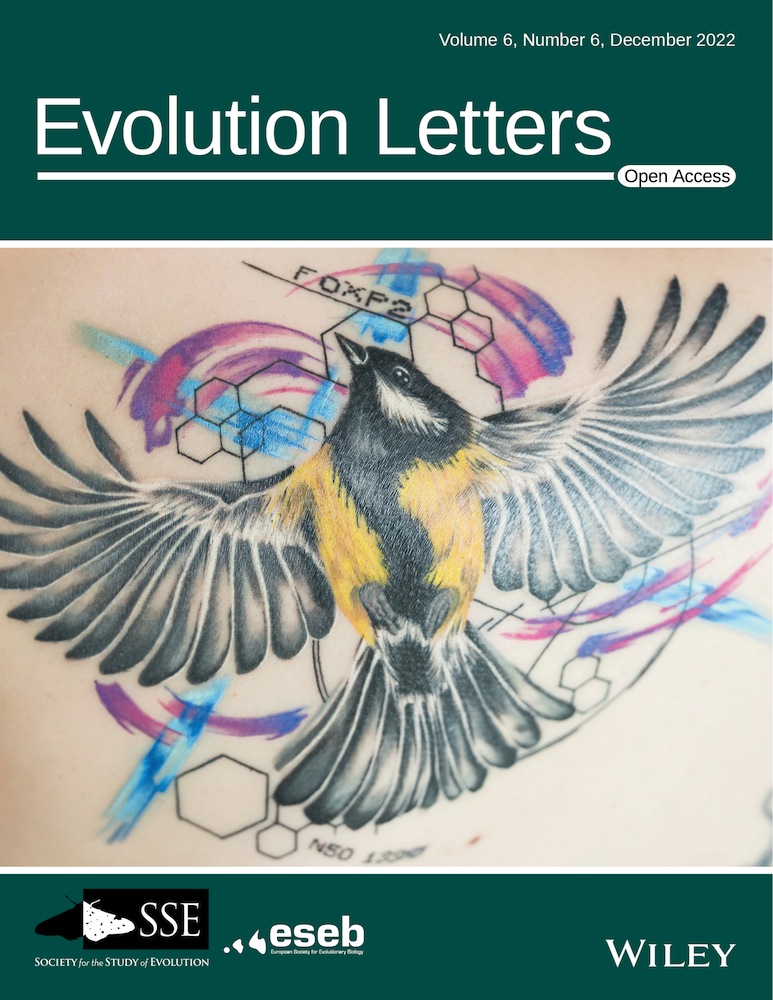在气候变化条件下,进化和塑性潜力的宏观生态预测因子不适用于淡水枝海的微观地理尺度
IF 3.7
1区 生物学
Q2 EVOLUTIONARY BIOLOGY
引用次数: 1
摘要
如果关键性状在未来气候条件下具有足够的遗传力,快速进化适应可以减少气候变化的负面影响。塑料对气候变化的反应也可以减少负面影响。因此,了解哪些种群可能通过进化或可塑性做出反应,可以提高对灭绝风险的估计。大量研究表明,一个种群的进化和可塑性潜力可以通过其所经历的时空气候变化程度来预测。然而,我们对这些关系的适用范围知之甚少。在这里,我们测试了温度的时空变化是否影响遗传变异和适应性的可塑性,以及一个关键的耐热性状(临界热最大值;利用淡水岩石池中大水蚤的超种群,在微地理尺度上对CTmax进行了研究。具体来说,我们想知道(a) CTmax和适应度对不同池间温度差异是否存在微地理适应性,(b)时间温度变化较大的池在CTmax或适应度方面是否具有更多的遗传变异或可塑性,以及(c)温度的升高是否影响CTmax和适应度的遗传力。虽然我们观察到CTmax和适应度的遗传变异和可塑性,以及不同池间的适应度差异,但我们没有发现温度变化与遗传变异或可塑性之间的关系。此外,我们在CTmax中观察到的遗传变异和可塑性不太可能足以减少气候变化的影响。在气候变化预测的较高温度条件下,D. magna发育时CTmax可塑性最小,遗传力低72%。相比之下,在较温暖的温度下,适合度的遗传力增加了53%,这表明在气候变化下,总体进化潜力的增加与CTmax无关。需要更多的研究来了解气候变化下的进化和塑性潜力,以及这种潜力在未来气候中将如何改变。本文章由计算机程序翻译,如有差异,请以英文原文为准。
Macroecological predictors of evolutionary and plastic potential do not apply at microgeographic scales for a freshwater cladoceran under climate change
Abstract Rapid evolutionary adaptation could reduce the negative impacts of climate change if sufficient heritability of key traits exists under future climate conditions. Plastic responses to climate change could also reduce negative impacts. Understanding which populations are likely to respond via evolution or plasticity could therefore improve estimates of extinction risk. A large body of research suggests that the evolutionary and plastic potential of a population can be predicted by the degree of spatial and temporal climatic variation it experiences. However, we know little about the scale at which these relationships apply. Here, we test if spatial and temporal variation in temperature affects genetic variation and plasticity of fitness and a key thermal tolerance trait (critical thermal maximum; CTmax) at microgeographic scales using a metapopulation of Daphnia magna in freshwater rock pools. Specifically, we ask if (a) there is a microgeographic adaptation of CTmax and fitness to differences in temperature among the pools, (b) pools with greater temporal temperature variation have more genetic variation or plasticity in CTmax or fitness, and (c) increases in temperature affect the heritability of CTmax and fitness. Although we observed genetic variation and plasticity in CTmax and fitness, and differences in fitness among pools, we did not find support for the predicted relationships between temperature variation and genetic variation or plasticity. Furthermore, the genetic variation and plasticity we observed in CTmax are unlikely sufficient to reduce the impacts of climate change. CTmax plasticity was minimal and heritability was 72% lower when D. magna developed at the higher temperatures predicted under climate change. In contrast, the heritability of fitness increased by 53% under warmer temperatures, suggesting an increase in overall evolutionary potential unrelated to CTmax under climate change. More research is needed to understand the evolutionary and plastic potential under climate change and how that potential will be altered in future climates.
求助全文
通过发布文献求助,成功后即可免费获取论文全文。
去求助
来源期刊

Evolution Letters
EVOLUTIONARY BIOLOGY-
CiteScore
13.00
自引率
2.00%
发文量
35
审稿时长
10 weeks
期刊介绍:
Evolution Letters publishes cutting-edge new research in all areas of Evolutionary Biology.
Available exclusively online, and entirely open access, Evolution Letters consists of Letters - original pieces of research which form the bulk of papers - and Comments and Opinion - a forum for highlighting timely new research ideas for the evolutionary community.
 求助内容:
求助内容: 应助结果提醒方式:
应助结果提醒方式:


